A complete list of vintage military watches used by the German Army (World War II edition)
During World War II, Germany surpassed Britain and Russia to become the most powerful country in the world.
What kind of watches did the military personnel of such a rapidly growing country wear?
Today, I will be explaining the German military watches, which do not receive much attention, focusing mainly on the period around World War II and dividing them into "Army," "Navy," and "Air Force."
So let's get started.
Divided into five parts
1. Organization of the German military 2. Characteristics of Army watches 3. Characteristics of Navy watches 4. A brief history of two companies that made chronographs for the Air Force
4-1. History of Hanhart
4-2. History of Glashütte Tutima
5. Features of Hanhart's chronographs
6. Characteristics of Tutima Chronographs
Finally, there is a summary.
If you want to watch the video, click here ↓
Explanation of the characteristics of vintage German military watches
Organization of the German army
First, let me introduce the organizational structure of the German military at that time.
If you don't understand this, you'll end up confusing it with modern stories and not being able to understand them.
Because the battlefields of World War I were mainly in Europe, advanced European nations such as Britain, Germany, and France understood the importance of aerial warfare and quickly created air forces.
They were Great Britain (1918), Italy (1923), Finland (1928), France (1934), and Germany (1935).
The Soviet Union was the earliest, having been formed in 1917.
Therefore, before the start of World War II, these countries had their own independent organizations called "Air Forces," and the air force chronographs of European countries were ultra-high-end models.
Therefore, in Europe, the organizations "Army," "Navy," and "Air Force" were clearly separated relatively early on.
From here on, I'll be focusing on the German Army.
Characteristics of German Army Watches
The British Army created the Dirty Dozen, which clearly required military specifications, so even though it is made up of 12 brands, the watches have subtle differences, but they are basically all easy to tell apart as they just have different logos.
For more information on British Army watches, please watch this video:
However, the German military does not have any standards such as the Dirty Dozen, nor does it select any particular watch brands.
Although there are a few well-known brands, there are still watches from various brands that bear engravings representing the German military, giving the impression that they were hastily assembled during the chaos of wartime.
As mentioned earlier, this is the engraving representing the German military, and it reads "DH."
DH is an abbreviation for "Deutsche Heer," where "Deutsche" means official watch and "Heer" means army.
All Army models other than those manufactured in Germany have this marking.
Now let's introduce some of the representative brands used by the German Army.
1. MIMO
Some of you may be somewhat familiar with Girard-Perregaux, but MIMO is Girard-Perregaux's European brand name.
If you look at the actual watch, you'll see that it closely resembles the Dirty Dozen used by the British Army.
The placement of the night paint, small second, and minute track are almost the same, but the only difference is that it does not have the Broad Arrow markings.


2. "Minerva"
Minerva also supplied the German Army with watches of almost the same style as the MIMO, and although the hands were different, most of them were made in the same style.
The back cover is engraved with "BODEN EDELSTAHL," which is German for "back" and "EDELSTAHL" for "stainless steel," meaning that the back cover is made of stainless steel.


3. Review Sports
The current brand, Revue Thommen, is a Swiss watch brand.
This is a model called "Sport" by the same company, which has been adapted as a military watch.
So, civilian watches were adopted for military use.
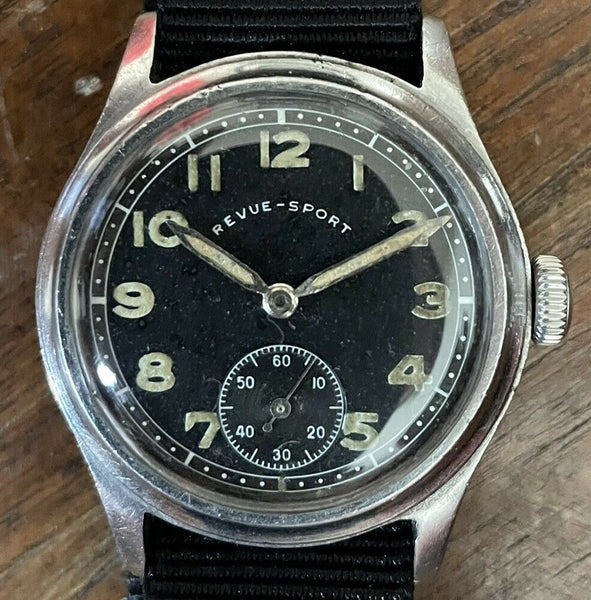

4. Record


Speaking of Record, it was one of the Dirty Dozen companies that supplied the British Army, but surprisingly, they also supplied the German Army.
Moreover, they are not the same watch, but have different dial designs.
Basically, when deliveries of these military watches were cancelled due to the chaos of war, the engravings were removed and the remaining stock was given to other countries.
However, the design of this watch is different from that of the British military, so it appears to have been clearly made specifically for the German military.
There are many more brands that supply army watches, but I could go on forever, so I'll stop here.
The standard rule of thumb is that if the case back has DH engraved on it, it is from the German Army.
Characteristics of German Navy Watches
The watches used by the German Navy are surprisingly easy to understand.
Basically, the dial has "KM" written on it.
This KM stands for Kriegs marine , which means "Imperial German Navy".
For the Army, a matte black dial was standard to prevent enemy forces from targeting the watch, but most Navy watches had white dials.
This is because, since the ship is at sea, the chances of individuals being targeted are low, and more to improve the visibility of the watch on board.
These watches have the KM logo and are supplied by a variety of companies, but the most well-known company is Alpina.

There is a number 592 below KM.
The 592 is the caliber number.
So, it is equipped with Alpina's caliber 592.
So how do you know it's made by Alpina? Well, the movement is clearly engraved with Alpina.

In this way, even if you can't tell at a glance from the dial which manufacturer it is, you can tell by the movement.
By the way, there are other numbers besides 592.
And this is a watch delivered by Zentra, but there is no caliber number written on it, just the brand logo.

Now, before introducing the watches used by the Air Force, let's look back at the history of the two companies that supplied watches to the German Air Force.
Hanhart
There were two companies that supplied chronographs to the German Air Force, but what kind of company was Hanhart, which was founded first?
I will explain this to you.
The company was founded in 1882 when Johann Adolf Hanhart opened a watch shop in the town of Diessen-Hofens on the Swiss-German border.
The company was founded in Switzerland, but moved its headquarters to Schwenningen, Germany in 1902.
In 1924, they completed the world's first affordable stopwatch suitable for everyday use, which shows that they were a company with advanced technological capabilities.
The next major turning point came in 1938 when the company developed a one-push chronograph equipped with Cal. 40, which marked the start of full-scale production of wristwatches.
The following year, a two-push pilot chronograph equipped with Cal. 41 and the mythical watch "Tachytele," equipped with both a tachymeter and a telemeter, were released.
The Tachytele was a watch equipped with a tachymeter and telemeter on the dial, and was rarely seen on the market, and it is believed that the number produced was quite limited.
The development of the chronograph, which could measure time accurately, made it popular with pilots and naval soldiers, and was used during World War II.
Glashütte Tutima
Now let me explain how the second company, Tutima, was founded.
In 1926, Ernst Kurz, who was working as a lawyer for the Bank of Saxony, was appointed to reconstruct DPUG (German Precision Watch Company Glashütte) following its bankruptcy.
During this reconstruction, it was reorganized into two groups.
that is
1. UROFA Uhren Rohwerke Fabrics Glashütte AG
(German movement manufacturer Glashütte)
Movement manufacturing contracted
2. UFAG Glashütte Uhrenfabrik AG
(Glashütte Watch Company)
Responsible for manufacturing exterior parts such as cases and crowns.
is.
The company was reorganized into these two groups, and in the same year, Ernst remained at the helm as founder, and the new Tutima was born.
In 1931, it was sold under the Tutima brand.
However, the word "Tutima" has not appeared even once up to this point.
So where did the word "Tutima" come from? It was used as a label given to the highest quality watches made by UFAG (the assembly company), which was responsible for the final process of watchmaking.
Even though we make a lot of watches, some are highly accurate and some are just not so accurate.
The name Tutima is used to distinguish it.
So, the name Glashütte Tutima comes from the fact that it is a Tutima quality watch made by a company called Glashütte.
Take a look at Hanhart's chronographs
From here on, we will explain what kind of chronographs each brand has made while looking at actual watches.
First, let's look at the early model of Hanhart.

One distinctive feature of the early models is that at the time, nickel-plated brass was still the mainstream material, so both the case and the back were made from that material.
Therefore, German chronographs from this period appear gold because the nickel plating has peeled off, revealing the underlying brass.
The second feature is that the bezel top has a triangular marker.

This bezel is bidirectional and would normally be painted red, but since the watch is already 80 years old, there is no paint remaining on any of the pieces.
Next, we will explain the improvements made to the "First" and "Second" models over the initial model.
The only change from the original model is that the case is still nickel-plated brass, but the back cover is now made of stainless steel.
There are also gold-colored parts on the back cover, so you can tell it's made of brass.
The later models have the "BODEN EDELSTAHL" engraving, as I explained earlier.
Below that, "WASSERGESCHÜTZT STOSSFEST" means waterproof.
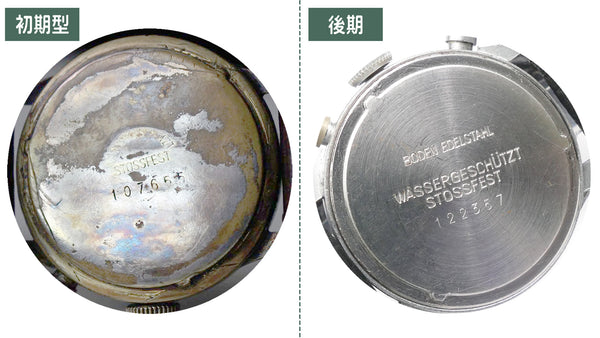
*Comparison of the early model back cover
The triangular marker has also been removed and replaced with a simpler design in which part of the edge has been shaved off and a red marker has been inserted in its place.
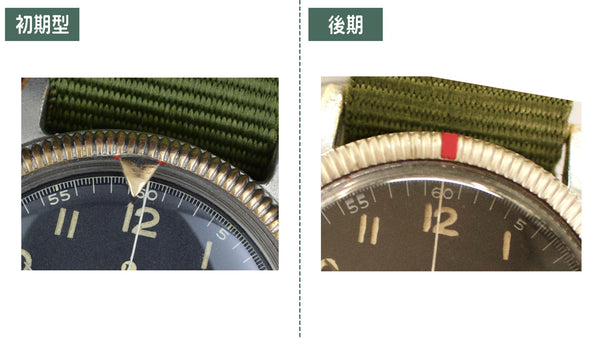
*Bezel marker design comparison
The first is a one-push button, and the second is two-push button.

The case is made of brass and nickel-plated, giving it a golden appearance, while the back is made of stainless steel.
The appearance is almost the same, except for the buttons.
Now let's look at the movement.
On the left is the Cal. 40 installed in the first watch, and on the right is the Cal. 41 installed in the second watch.
There is little difference in appearance, but the first has five pillars on the column wheel while the second has eight.
Additionally, a brake lever has been added to the second model, which was not available on the first model.
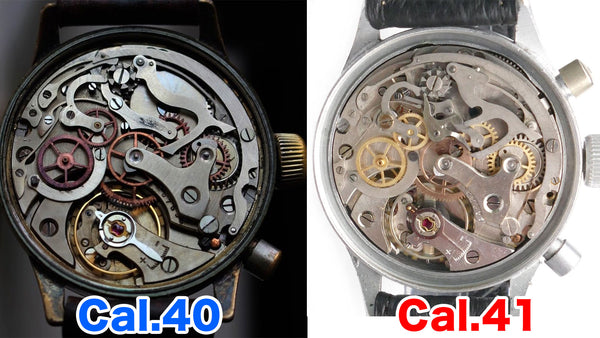
Now let's take a look at the design.
The left side is a smooth bezel and the right side is a coin edge bezel.

It is not clear whether different designs were issued depending on the organization using them, but it is said that the smooth bezel was delivered to the Navy and the coin edge bezel was delivered to the Air Force.
However, if it is true that they were classified, then there are coin-edge bezel type chronographs adopted for the Air Force that have the KM logo, so it is likely that the Air Force versions were given to the Navy.
A Look at Glashütte Tutima Chronographs

There were a variety of patterns for Hanhart, but not many for Tutima.
First of all, the features of the early model are the same as those of the Hanhart mentioned above, with the triangular marker and the back cover also made of brass, while the improvements are the elimination of the triangular marker and the use of stainless steel for the back cover.
The movement is slightly smaller than the Hanhart movement, so the case size is also smaller at 39mm.
Tutima only has one movement, the Cal.59.
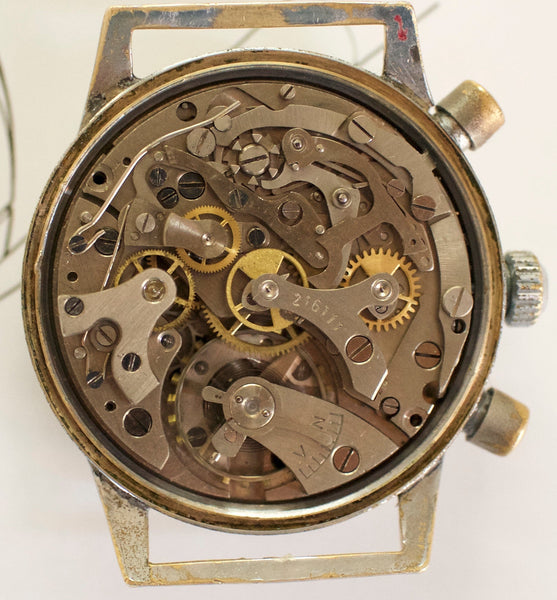
The Hanhart was equipped with a flyback function after the second model, which had two push buttons, but the Tutima had the flyback function from the beginning.
And for Tutima, there is also a pattern like this one that does not have the Tutima T mark or the Glashütte logo.

It was primarily a watch made for the Air Force, not for civilian use.
Also, since it was war time, there would have been no need to go to the trouble of making one for civilian use.
Therefore, it is unlikely that the models without the logo were made for civilian use, and we believe that these models without the logo were distributed to knowledgeable people in charge of directing the war for a different reason, unrelated to the military.
What we can learn from the two companies' chronographs
There are no documents that clearly state the specifications, like the Mark 11 used by the Royal Air Force, but I have tried to derive my own specifications based on the construction of these two companies' watches.
1. Arabic numerals on a black dial with white scales
2. Use of radium luminous paint
3. Use of Cobra needles
4. Bezel tops should be marked with a red marker
5. Use 17 support stones (rubies)
6. It is a highly accurate German-made watch.
I think that may be the case.
summary
So today, I have introduced you to some military watches used by the German army during World War II.
Of all military watches from this period, the British military watches are the easiest to identify.
This is because the specifications are clearly defined, and the manufacturers that supplied the watches were well-known brands that we still recognize, such as Omega, Jaeger-LeCoultre, and IWC, so there is a sense of familiarity and we know the products right away.
On the other hand, I think it's hard to appreciate the beauty of German military watches unless you really dig deep into the world of military watches.
However, I think that those of you who have watched this video up to this point have been able to gain a certain understanding of the characteristics of German military watches, and I would be happy if you have become even a little interested.



